Walking the cobblestone streets of Oaxaca City, the smell of toasted chiles and spices draws me in. Here, food is both art and history. Oaxaca’s seven moles are more than sauces—they’re stories. My first taste of mole negro in a family taquería was like stepping into centuries of tradition.
This is the real Oaxacan cuisine. Every dish tells of Zapotec roots and Spanish colonial kitchens coming together in something amazing.
The smoky taste of mole chichilo and the bright herbs of mole verde show these sauces are more than recipes. They’re cultural symbols, passed down through generations like family heirlooms. Traveling to Oaxaca City means tasting moles as living proof of resilience and creativity.
Each bite connects ancient techniques with today’s tastes.
Key Takeaways
- Oaxaca’s seven moles represent its culinary soul, blending Indigenous and Spanish heritage.
- Authentic Oaxacan cuisine thrives in family kitchens and bustling markets, not just restaurants.
- Every mole variety—from rojo to manchamanteles—offers a distinct journey of flavors and textures.
- Culinary travel to Oaxaca City reveals how tradition evolves through communal cooking practices.
- Mole’s complexity mirrors Oaxaca’s identity: rich, layered, and deeply rooted in cultural pride.
My Journey into Oaxaca’s Rich Culinary Heritage
Walking through Oaxaca’s cobblestone streets, I felt the heartbeat of Oaxaca food tourism in every corner. The air hummed with the crunch of toasted seeds and the earthy scent of traditional Mexican mole sauce. Vendors and tortilla makers waved like silent guides, inviting me deeper into a world where every dish tells a story.
First Impressions of Oaxaca’s Food Scene
The city’s markets were my first lesson in sensory immersion. Bright mole pastes glistened in clay pots; women grinding chiles in volcanic stone molcajetes echoed centuries of tradition. A vendor’s words lingered: “This is not just food—it’s a language.” I scribbled notes, realizing every bite here was a dialogue with history.
The Cultural Significance of Mole in Oaxacan Identity
“Mole is our DNA,” said Doña Rosa, a chef in her tianguis stall. “It’s born in kitchens where grandmothers whisper secrets into grinding stones.”
Her words framed the foundation: traditional Mexican mole sauce isn’t just a dish. At festivals, I watched families layer 30+ ingredients—chiles, spices, chocolate—over hours, mirroring the region’s layered heritage. Each variation, from negro to coloradito, became a chapter in Oaxaca’s storybook.
Finding Authentic Mole in Oaxaca City
Authenticity demands curiosity. Here’s how to navigate:
- Seek family-run fondas where cooks prepare mole in open kitchens
- Visit Mercado Benito Juárez at dawn to watch spice blends being measured by hand
- Ask locals for “las casas de mole”—hidden homes where recipes are heirlooms
| Experience Type | Description | Where to Find |
|---|---|---|
| Authentic | Handcrafted in family kitchens; uses ancestral techniques | La Olla de Doña Juana (Centro Histórico) |
| Commercial | Streamlined versions for tourists | Main plaza eateries |
For deeper exploration, Mexican gastronomy tours offer guided paths to these culinary guardians. Every spoonful of mole became a bridge to Oaxaca’s soul—one I now invite you to taste.
Understanding Mole: Mexico’s Most Complex Sauce
Imagine standing in a sunlit kitchen filled with the earthy scent of roasted chilies. Making mole is a slow and careful process, passed down through generations. In Oaxaca, this sauce is more than just food—it’s a living history of Oaxacan culinary traditions.
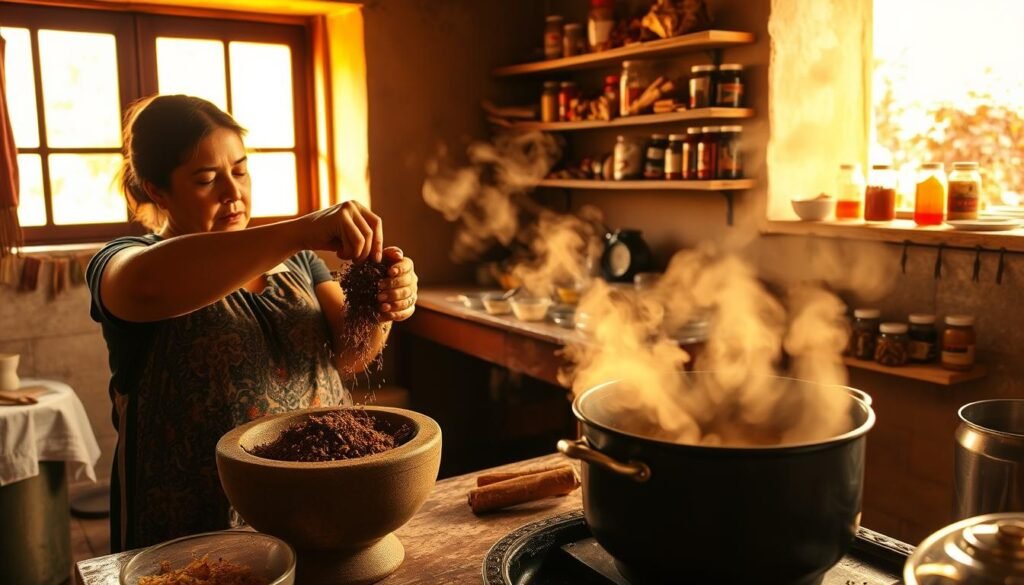
Mole is all about its layers. A master cook showed me how it starts with toasting dried chilies over flames until they blister. This indigenous Mexican cuisine turns simple ingredients into something deep. Here’s how it happens:
- Roast chili varieties like guajillo and ancho until fragrant.
- Grind toasted nuts and seeds with spices like cinnamon and cloves.
- Simmer the base with broth, letting flavors meld for hours.
- Finish with dark chocolate to balance heat and bitterness.
“Mole is our soul in a bowl,” said Doña Rosa, a third-generation mole maker. “Every grain tells a story.”
The sauce’s roots go back to before the Spanish arrived. Aztec cooks used chili-and-seed pastes. Then, Spanish colonization added almonds and cloves, mixing new flavors into the mix. Yet, the heart of mole stays true to indigenous ways—like grinding ingredients on metates (volcanic stones).
Every part of mole has a role: tangy plantains balance the spice; sesame seeds add creaminess. Tasting mole is like tasting centuries of change. Its complexity reflects Oaxaca—a place where old and new meet at the table.
Mole Negro: The King of Oaxacan Cuisine
Imagine a sauce so deep, it feels like a story from centuries ago. Mole negro is made from over 30 ingredients, toasted, ground, and simmered into a golden liquid. It’s not just food; it’s a tradition where burnt tortillas add smokiness, chiles like mulato and pasilla bring heat, and Mexican chocolate balances it all without sweetness.
The Traditional Ingredients and Preparation
Mole negro is rooted in tradition. Chefs use metates, volcanic stone slabs, to grind spices. The process is slow: chiles are toasted, nuts and seeds toasted separately, and the mix simmers for hours. The result is a sauce with layers, like a symphony in a bowl.
- Chiles: mulato, ancho, pasilla
- Chocolate: pure, unrefined disks for earthy depth
- Warmth: sesame seeds, almonds, and plantains
Where to Taste the Best Mole Negro in Oaxaca City
Look for places where tradition and passion meet. Culinary travel experts recommend Casa Oaxaca for its smooth mole. Restaurante Coronita serves it with tamales for a rustic feel. Don’t miss Mercado 20 de Noviembre’s street stalls, where vendors pour mole over fresh corn tortillas, a simple yet profound experience.
My Personal Experience with Mole Negro
My first bite at a family-run cantina near Monte Albán left me speechless. The aroma was earthy and mystical, filling the room before the dish arrived. Each spoonful was a new discovery: bitterness from the chiles, richness from the chocolate, and a hint of allspice that lingered like a whisper. It was more than food; it was a conversation with history.
For travelers, trying mole negro is a way to connect with Oaxaca’s heart—a ritual as important as the city’s cobblestone streets or its lively markets. Every bite invites you to appreciate the slow, deliberate art of Oaxacan cooking.
Colorful Variations: Mole Rojo, Amarillo, and Coloradito
Exploring Oaxaca’s mole varieties is like stepping into a world of flavors. Each color has its own story. My first time trying mole rojo was at a family kitchen. There, three generations mixed traditional Mexican mole sauce with toasted chiles and chocolate.
The traditional Mexican mole sauce left a lasting taste. It was a mix of heat and depth.
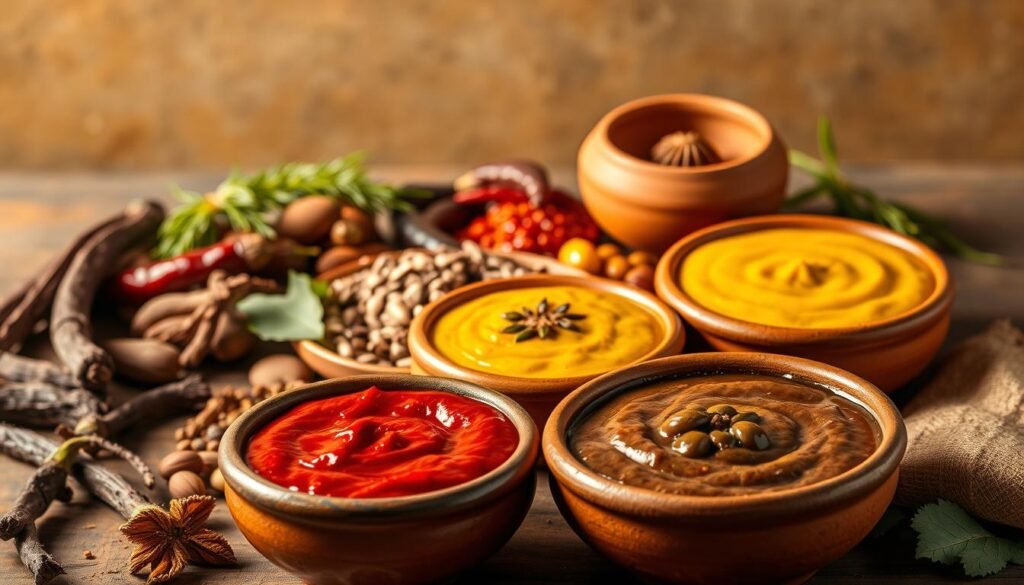
| Mole Type | Flavor Profile | Must-Try Spot |
|---|---|---|
| Mole Rojo | Smoky red chiles, raisins, and cinnamon | Casa Oaxaca (Centro Histórico) |
| Mole Amarillo | Golden annatto seeds, hoja santa, and tangy citrus notes | Mercado de Benito Juárez (Sunday market stalls) |
| Mole Coloradito | Plantain sweetness with a chili-kissed finish | La Olla (colonial courtyard restaurant) |
At a Mexico food travel guide spot, mole amarillo was a highlight. Its golden color came from achiote and fresh herbs. It tasted like a ray of sunshine.
Mole coloradito was a surprise at a family kitchen. Its rich red color paired well with pork. Plantains made it smooth. These dishes are more than food; they’re family traditions.
Whether at a busy market or a cozy kitchen, each bite connects us to the past.
The Lesser-Known Treasures: Mole Verde, Chichilo, and Manchamanteles
Oaxaca’s food scene is full of hidden gems. My exploration found moles that show the true taste of authentic Oaxacan cuisine. These dishes, like mole verde, chichilo, and manchamanteles, highlight the region’s
Mole Verde: The Fresh and Vibrant Alternative
In the market, a vendor’s traditional mole preparation amazed me. Her mole verde was bright, with tomatillos and pumpkin seeds. It was like a burst of freshness, unlike darker sauces.
Chichilo: The Smoky, Mysterious Mole
A village elder showed me how chichilo is made. Charred chiles and toasted corn give it depth. The traditional mole preparation uses ash from tortillas, passed down through generations. It’s like tasting Oaxaca’s history in every bite.
Manchamanteles: The “Tablecloth Stainer”
This authentic Oaxacan cuisine dish is known for staining clothes. But it’s a flavor explosion. Sweet pineapple and plantains mix with chili heat. My shirt’s stain became a symbol of my culinary journey.
Beyond Mole: Other Must-Try Oaxacan Specialties
Exploring Oaxaca beyond moles, I found dishes that show the region’s true flavors. From street carts to family tiendas, these dishes reveal the heart of authentic Oaxacan cuisine.
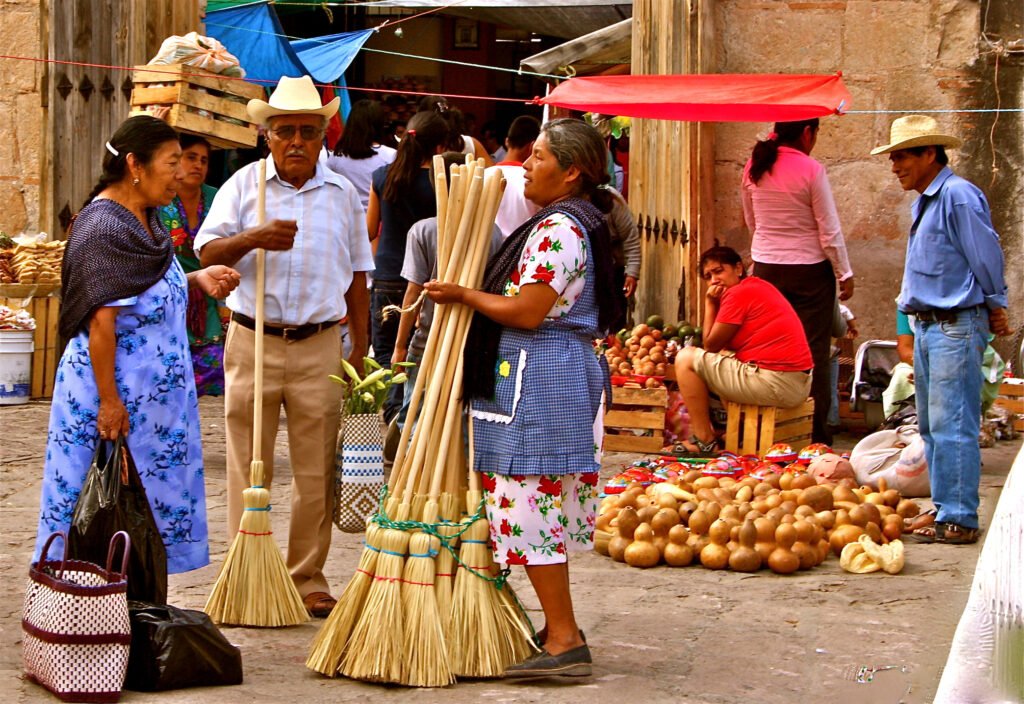
Tlacolula Market, Mexico. Selling And Buying Handmade Brooms At Rural Market In Tlacolula, Mexico
Tlayudas: Oaxaca’s Crispy, Customizable Masterpiece
A crispy tortilla is stretched wide, fried until it crackles, then topped with refried beans and asiento. Add Oaxacan string cheese and chicharrones for a perfect bite. The best ones are made at dawn in Mitla Market, where women cook them over open fires.
The secret is finding the right balance. The tortilla’s crunch, the cheese’s melt, and the smoky flavor all come together. Popular toppings include:
- Re-fried black beans
- Grilled chorizo or chicken
- Pickled onions and fresh crema
Chapulines and the Art of Eating the Earth
My first try of toasted grasshoppers seasoned with salt and chile was amazing. They taste like sun-dried herbs and are packed with protein. Vendors at Benito Juárez Market sell them with huitlacoche and chicatanas, showing indigenous Mexican cuisine is alive here.
Paired with a cold beer, they become a special ritual. It connects you to Oaxaca’s ancient tastes.
Cheese, Chocolate, and the Art of Slowness
No visit is complete without trying Oaxaca’s quesillo—stretchy cheese wrapped in banana leaves—and tasting chocolate made in metates. At Chocolate Mayordomo, I saw almonds, cinnamon, and cacao blend into bars with depth. Here’s a table of regional cheeses:
| Cheese | Description |
|---|---|
| Quesillo | Stretchy white cheese for melting |
| Panela | Semi-hard cheese for shredding in soups |
Enjoying these with Oaxaca culinary experiences like midnight tlayuda runs or market tours is essential. Every bite is a conversation between past and present.
Culinary Travel to Oaxaca City: Planning Your Gastronomic Adventure
Dive into Oaxaca’s food scene by visiting during its lively festivals. My first trip was during the Guelaguetza in July. I enjoyed mole negro under the sun. In October, the Día de los Muertos brings moles with deep flavors and scents of marigolds.
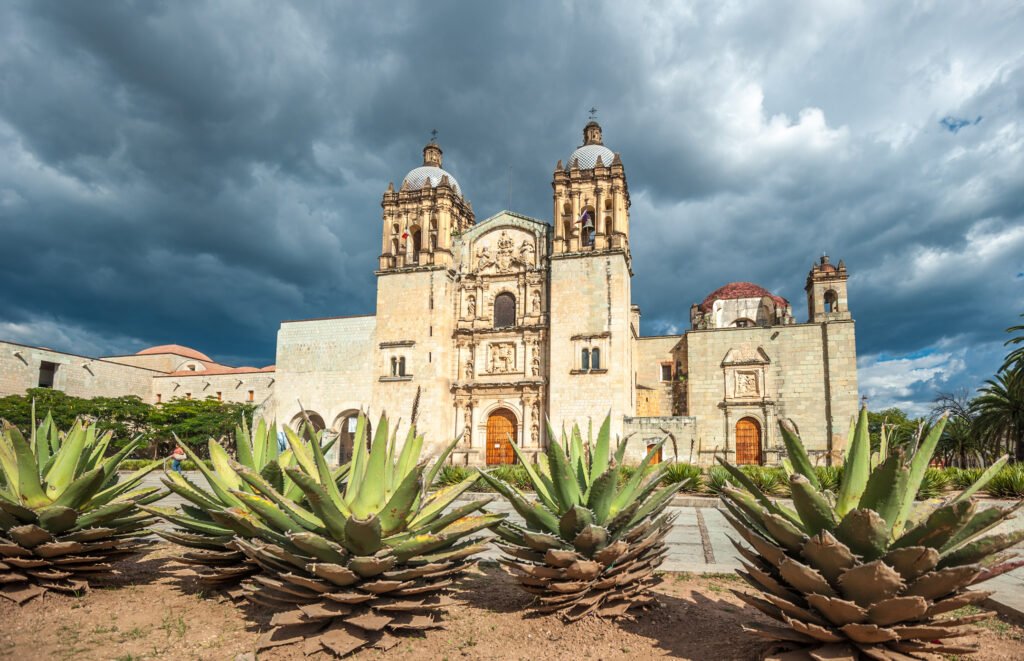
Image Of Church Of Santo Domingo De Guzman In Oaxaca, Mexico
Best Time to Visit for Food Festivals
- July: Guelaguetza’s live music and mole tastings
- October: Day of the Dead’s ceremonial dishes
- December: Christmas markets with chocolate molé de chile
Essential Food Markets and Cooking Classes
Start at Mercado 20 de Noviembre in the morning. Tortilla vendors steam their goods in the early light. For Oaxacan cooking classes, Casa Crespo’s hands-on sessions let you grind mole spices by hand. Mercado Benito Juárez’s Oaxaca food markets offer mezcal and chili varieties like a painter’s palette.
| Market Gems | Highlights |
|---|---|
| Mercado Central | Chapulines, fresh mole pastes |
| Mercado de Abastos | Chocolate vendors, regional herbs |
Crafting Your Mole-Tasting Itinerary
A 3-day plan could blend:
- Day 1: Market tours + cooking classes for hands-on mole prep
- Day 2: Lunch at La Olla, followed by a chocolate-making demo
- Day 3: Day trip to Tlacolula for village moles
Take your time—enjoying a mole’s layers is a slow process. Local guides can help you navigate the food scene.
How Oaxacan Cuisine is Reshaping Global Gastronomy
In New York and Tokyo, Oaxacan flavors are now on Michelin-starred menus. This shows that Oaxacan food culture knows no borders. Chefs around the world are making dishes like mole and chapulines in new ways. Yet, the essence of Oaxaca stays true.
I’ve tried mole negro turned into a duck confit glaze in Brooklyn. It brought back memories of Oaxaca’s markets. The smoky flavor was unmistakably Oaxacan.
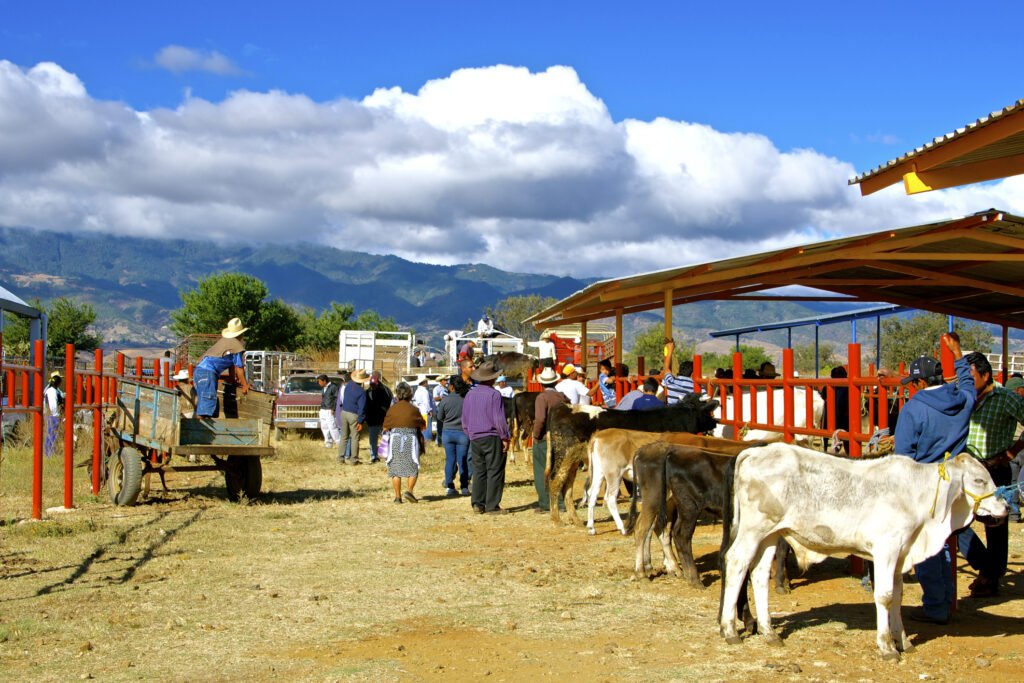
Cattle Market, Mexico. Young Cowboy With Cattles At Rural Livestock Market. Zaachila, Oaxaca, Mexico
- Enrique Olvera uses corn-based nixtamalization in molecular gastronomy.
- Daniela Soto-Innes mixes Oaxacan herbs with Nordic foraging.
- Alex Stupak combines Oaxacan chocolate with modern desserts.
A table comparing traditions shows how it’s evolved:
| Traditional Use | Modern Interpretation |
|---|---|
| Mole negro as ritual dish | Featured in tasting menus globally |
| Chapulines as street snacks | Star ingredient in fusion tapas |
| Handmade tortillas | Used in gluten-free haute cuisine |
But this love for Oaxacan food comes with a big responsibility. Chefs must respect where the food comes from. They should buy ingredients directly from Oaxacan farmers.
A molinera (mole maker) once told me, “Our recipes are alive; they evolve, but their essence must remain.” This is the key. Travelers enjoy mole in Oaxaca, while chefs elsewhere innovate without losing the tradition’s heart. The journey from Oaxaca to Paris shows food’s ability to unite, but always with respect.
What Makes Oaxaca Mexico’s True Gastronomic Capital
Oaxaca’s culinary greatness comes from its rich traditions. In the markets, I’ve seen how Oaxacan cuisine blends old and new. This mix is seen in every Oaxaca food tourism experience, from hot tlayudas to chocolate molinillos.
Indigenous and Colonial Whispers in Every Bite
Think of a tortilla made by Zapotec hands, topped with pork adobo from old convents. This mix shows Oaxaca’s heart. In Teotitlán del Valle, women use ancient stones to make masa de maíz. Nearby, a special sauce blends almonds and spices in a way that’s timeless.
Timeless Techniques, Timeless Flavors
Preserving traditions is not just about the past. It’s about keeping alive. At a family-ownedmolino de nixtamal, I saw how stone-ground corn keeps its flavor. The metate, a volcanic slab, turns chiles and seeds into vibrant pastes. “Sin metate, no hay alma,” Doña Rosa said, her hands stained with achiote.
A Community Guarding Flavor’s Legacy
Oaxaca’s chefs are more than cooks; they’re storytellers. At La Oraza, chef Elena Zapata mixes old recipes with new techniques. Market vendors like Don Carlos sellchapulines by the zócalo, showing their pride in tradition.
Oaxaca is special because it’s a living museum. Every dish, from tortillas to mezcal, tells a story of resilience and creativity. To taste it is to experience Mexico’s culinary soul.
Conclusion: The Enduring Magic of Oaxacan Moles
Walking Oaxaca’s cobblestone streets, I saw mole as more than a sauce—it’s a language. Each of the seven varieties shares a story of spices, history, and hands stirring pots for centuries. The negro’s depth, the verde’s freshness, and the smoky chichilo all whisper of resilience and creativity.
Culinary travel to Oaxaca City shows how these sauces are more than recipes; they’re living heirlooms passed down through generations.
Authentic Oaxacan cuisine is full of contrasts—precision and spontaneity, tradition and innovation. A cook’s choice of chilies or touch of chocolate turns a formula into art. In markets like Mercado de Benito Juárez, I saw how Oaxaca mole varieties are both a communal treasure and a deeply personal expression.
Every spoonful is a dialogue between past and present.
To taste mole away from its birthplace is like reading a poem in translation. Its fullness is only fully experienced here, where the air carries hints of toasted seeds and the valleys nurture the ingredients. This is where ancestral techniques meet modern curiosity, inviting travelers to savor not just flavors but a legacy.
Culinary travel to Oaxaca City becomes a pilgrimage—for those who seek stories in every bite. The moles remind us: food is a bridge. Cross it, and you’ll find a culture that turns ingredients into heritage, one slow-cooked pot at a time.


